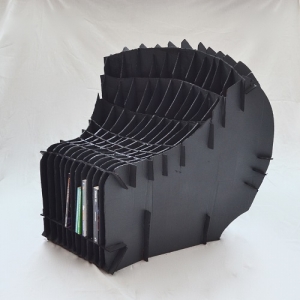This spring, some not-so-typical chairs were on display in the University of Maine at Presque Isle’s Center for Innovative Learning [CIL]. What set these particular chairs apart from the various stools, computer chairs, and cushioned seats available in the CIL is that these works of art were made from cardboard.
The Cardboard Chair project was done in Heather Sincavage’s Design Foundations II class. Fifteen people made chairs entirely of cardboard. As part of the assignment, each chair had to hold a 150 lb. person and extra credit was given to those who did not use adhesive.
Sincavage, UMPI Assistant Professor of Fine Art, said the point of the project was for students to explore using serial planes or platonic solids as a design component. Students were also asked to incorporate use and environment into their designs–specifically, they were each to create a reading chair for a specific spot in the CIL–and they were to consider how they like to read, where they like to read in the CIL, and how the chair reflects the environment of the CIL.
Director of Library Services Roger Getz selected five chairs to be displayed at the CIL in their intended location. The chairs that were placed on display were created by Amanda Whitten, AJ Naffziger Mullane, Daria Wozmak, Dylan Michaud, and Dylan Ouellette.
After these chairs were on display for approximately three weeks, a “BEST of” chair was selected. The winning chair was made by Dylan Ouellette. His chair was on display on the second floor beside a large window and used serial planes and no adhesive. It was so sturdy that one could even stand on it. Additionally, the chair had a design feature that held books for reading later.
“The Center for Innovative Learning is always excited to team up with classes and programs to highlight our students’ incredible talent,” Getz said. “The work accomplished in our Art Program is just one example of the creative insights of our students. These chairs were far beyond my expectations and it was wonderful for the CIL to be able to play a small role in this project. I would like to thank all of the students, as well as Professor Sincavage, for allowing us to be part of their project.”

